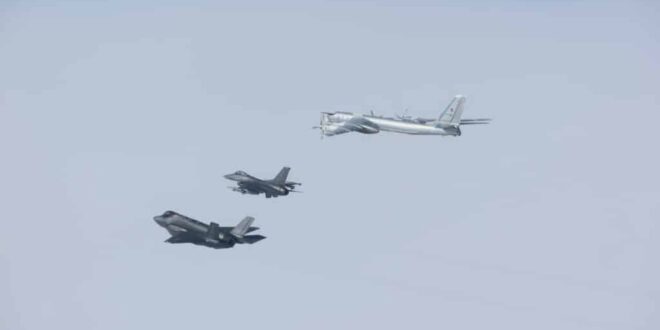Russian and Chinese strategic bombers conducted a combined patrol near Alaska on Wednesday in the latest sign of military cooperation between the two U.S. adversaries. The incident underscores the determination of China and Russia to deepen their military cooperation and demonstrate their capability to threaten the American homeland.
Russian bombers have conducted such patrols since the Cold War, and Chinese and Russian bombers have operated together before. But this is the first time they have done so in the Alaska Air Defense Identification Zone (ADIZ). An ADIZ is a zone in international airspace where aircraft identification is required for national security.
North American Aerospace Defense Command (NORAD) said it “detected, tracked, and intercepted” the flight of “two Russian TU-95 and two PRC H-6 military aircraft operating” in the Alaska ADIZ on July 24. While the bombers did not enter U.S. airspace, two Canadian CF-18 Hornets, two U.S. F-35 Lighting IIs, and two U.S. F-16 Fighting Falcons intercepted the bombers, according to a photo released by NORAD.
The Russian strategic bombers were Tu-95MSs, escorted by Su-35S and Su-30SM fighters. Known to NATO as the “Bear-H,” these bombers can carry nuclear as well as conventional weapons. The Xian H-6 (Hōng-6), a Chinese version of the Soviet Tupolev Tu-16, is a strategic bomber that can carry conventional or nuclear weapons and launch anti-ship missiles. The Russian Defense Ministry stated that H-6Ks were used in the patrol. This is one of the more modern variants of that aircraft, capable of carrying nuclear weapons as well as conventional air-launched ballistic missiles.
Secretary of Defense Lloyd Austin said that while the patrol “was not a surprise,” it was “the first time that we’ve seen these two countries fly together like that.” Pointing to China’s support for Russia’s illegal war against Ukraine, Secretary Austin reiterated the administration’s “concern” over the deepening relationship between the two countries and said Washington will continue to watch “how this relationship continues to develop.”
The Russian Ministry of Defense described the action as a “a joint air patrol over the Chukchi Sea, the Bering Sea, and the northern part of the Pacific Ocean.” A spokesperson for China’s Defense Ministry said that the flight was Russia and China’s eighth joint strategic air patrol since 2019.
In August of 2023, 11 Russian and Chinese ships conducted combined naval patrols in international waters off the coast of Alaska. In March, Air Force Gen. Gregory M. Guillot, commander of NORAD and U.S. Northern Command, predicted that Chinese aircraft could begin patrols within the American ADIZ “as early as this year.” Likewise, the Pentagon’s 2024 Arctic strategy highlighted that Russia and China are increasingly “collaborating in the Arctic with implications for the security of the United States and our Allies and partners.”
The two nations are also cooperating elsewhere. NATO’s Washington Summit Declaration earlier this month highlighted the “deepening strategic partnership between Russia and the PRC,” labeling China as “a decisive enabler of Russia’s war against Ukraine.” Beijing “continues to pose systemic challenges to Euro-Atlantic security,” the alliance declared.
The combined patrol demonstrates that China and Russia share a common hostility toward the United States and understand the value of partners. Following the recent NATO summit, it is important for Americans not to neglect their partners. As China and Russia cooperate more closely, the United States will need its allies more than ever.
Americans have long assumed they would have to deal with only one great power adversary at a time. Based on the growing relationship between China and Russia, Congress should ensure that Pentagon war plans, as well as the associated weapon and munition requirements, are not based on outdated assumptions.
 Eurasia Press & News
Eurasia Press & News




